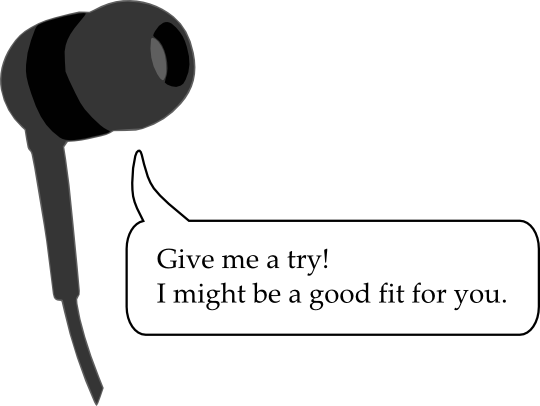Successfully deploying in-ears takes time, patience, and a willingness to experiment.
Please Remember:
The opinions expressed are mine only. These opinions do not necessarily reflect anybody else’s opinions. I do not own, operate, manage, or represent any band, venue, or company that I talk about, unless explicitly noted.


IEM (In Ear Monitoring) systems have an undeserved reputation:
They are supposed to fix everything in an instant.
That’s baloney, but it’s easy to believe – and it’s also got a kernel of truth embedded in it.
The true thing about in-ears is that they do solve one particular problem in an instant. That problem is audible “wash” from on-stage monitor loudspeakers. Yank the wedges off the stage, hand the artist a receiver and a set of earbuds, and *Bamf!* Life is a lot quieter, and feedback stops being an issue for monitor world – well, in the usual sense, anyway.
“Bamf,” by the way, is the sound made when something magical happens, and that magical something is accompanied by a good-sized puff of grey or black smoke. Magical events accompanied by white smoke go “Poof!”
The false notion about in-ears is that, right out of the box, you are assured of superior monitoring. That’s a lie. If you buy an IEM rig and get a perfect solution on the first day, you are one lucky dog. I’m not bagging on in-ears! I think they’re great, but you have to be realistic about ’em.
IEM systems also describe themselves as “personal monitoring systems,” and the word “personal” is very key. One size doesn’t fit all (literally, in point of fact). When you take the leap into using IEMs, you can save yourself a ton of disappointment and consternation by embracing this idea:
Getting personal monitoring to work for you is going to take more work than just opening the box and connecting the cables.
They Are The Driver, And You Are The Horn
In a certain sense, an IEM earpiece is like a compression driver that a loudspeaker manufacturer would mate to a horn.
It might not be obvious from first glance, but the high-frequency section of most pro-audio loudspeakers is actually two components. The part that’s easy to see from the outside is the horn/ waveguide/ lens/ etc. It’s a carefully designed device (albeit a passive one) that helps the HF driver couple efficiently with the air in the room. Any horn you run into will have a certain subset of HF drivers that it can mate with properly. If the HF driver doesn’t properly mate with a given horn, you can end up with a loss of efficiency, poor frequency response, or both.
Now, manufacturers usually want to sell a good number of horns and/ or drivers. With that in mind, some defacto standards have appeared for HF driver exit diameters, general compatibility, and attachment methods. There are almost certainly some horns and drivers that are made specifically for each other, and won’t work in any other combination, but there are a lot of interchangeable parts out there as well. If you’re a builder of HF drivers, you can pick an overall horn spec and build a bunch of drivers that will fit nicely.
Things aren’t quite that nice for IEM earbud designers.
Sure, most human ears are within a certain percentage of an average canal shape and canal opening diameter, but even folks in the +/- 1 standard deviation range can have a lot of variation. An IEM manufacturer has to figure out how far they’re willing to go to get a workable fit for most users, while keeping their costs at a sane level.
Usually, this means including a few different-sized “sleeves” for the system’s included earbuds.
Even so, you may have trouble getting a good fit. If you don’t get a really good fit with your in-ears, you’re going to have a crappy time. If the driver isn’t right for the “horn” (actually, your ear canal), all the upstream components – the receiver and transmitter – effectively lose the ability to do their job well. A bad fit means less usable level, along with more stage-volume leakage (a double whammy). A bad fit means sound that’s tinny, bizarre, or downright painful.
A bad fit makes the best IEM system seem like a bad investment.
Personal Monitoring Means Working On A Personal Solution
There’s good news here, though. The reality is that, by purchasing a good in-ear transmitter and receiver, your investment is on a great footing. All you have to do is complete that investment properly.
In general, I would urge anyone buying an IEM rig to view the supplied earbuds as a “starter kit” only. Also, I would urge you to view the expense of the system in the box as only about 1/2 to 2/3 of the total cost necessary for a good solution. If the “starter kit” gets you great results without having to buy any additional pieces, then that’s killer. However, you shouldn’t expect this outcome.
What you should expect is to use the in-box phones to verify that the system can transmit and receive audio that has interference and harmonic distortion at, or below, the threshold you are willing to accept. At that point, you need to make the rig yours.
If the drivers in the buds that came with the system are what you need, great. If not, go hunting for an earset that can handle what you want. (Not every set of IEM drivers will be great for low-frequency content at high-volume. I you’ve got to have that, you may need to do some more shopping.) Once you’re sure that the drivers can do what you need, you can start experimenting in earnest.
Get yourself a bunch of compatible sleeves in different sizes and materials. Get some “flanged” sleeves, too. Try to get maximum comfort, along with a bud-to-canal seal that you have to work hard to break. Try using different sleeve sizes in different ears – I’m willing to bet that your ear canals are not exactly the same size on both sides of your head. (Mine aren’t.) Experiment with letting the cable for the buds hang, and putting the cable around the top and back of your ear. Really “go for it” in rehearsals to see how well the fit holds up in response to movement, sweat, and jaw opening.
If you can’t get quite what you want, then you should spring for custom molds. (This is the ultimate in terms of making an in-ear rig yours. Custom molds fit you exactly, and nobody else.) I’m not an IEM user myself, because I’m not a musician and I usually mix wedges, but I do have custom-molded earplugs. I’ll just say this – when I occasionally forget my customs and have to use a set of “generic fit” musician’s plugs, the difference in comfort and ease of use is NOT subtle.
The bottom line?
Just getting an in-ear rig is the beginning of the personal monitoring journey. To get to the end of the journey, you’re going to have to do some work and take some wrong turns. However, when you do finally get your system properly personalized, it will be a thing of beauty.
You just have to be willing to actually go on the adventure.
 Nathan Spenser and The Low Keys
Nathan Spenser and The Low Keys
 Triggers & Slips
Triggers & Slips